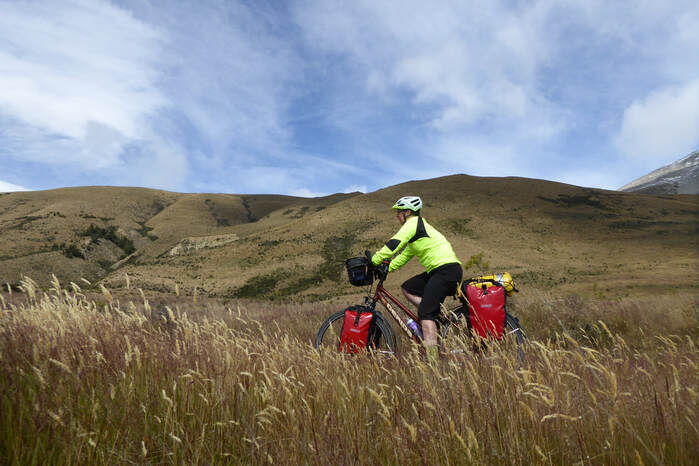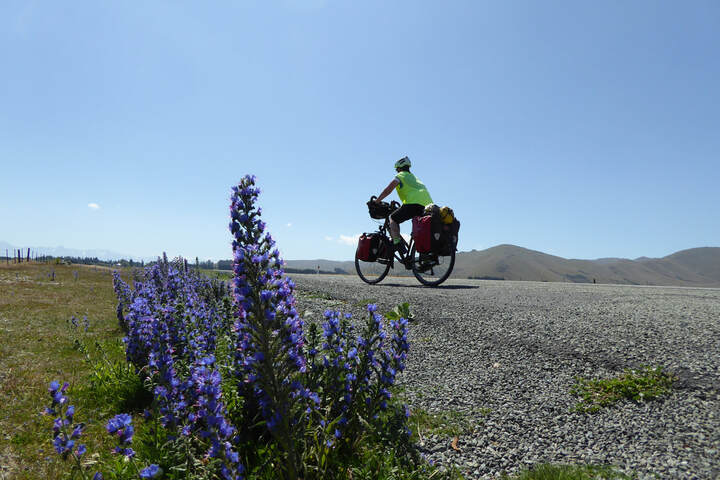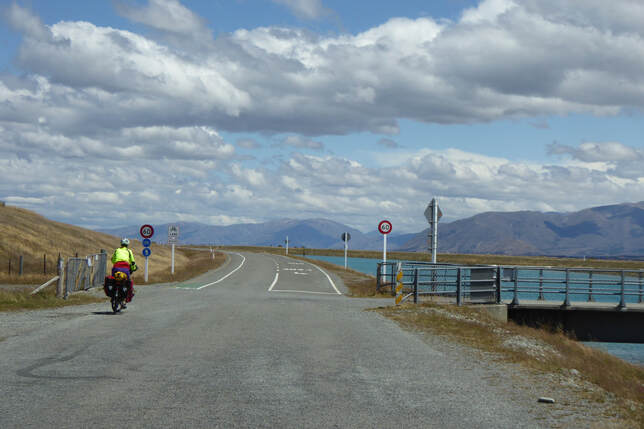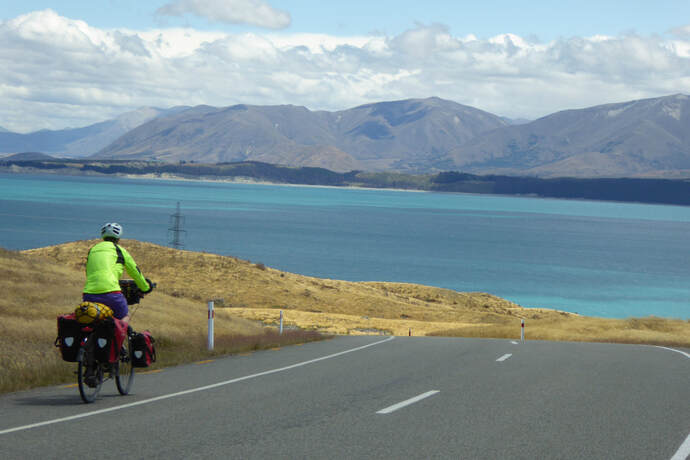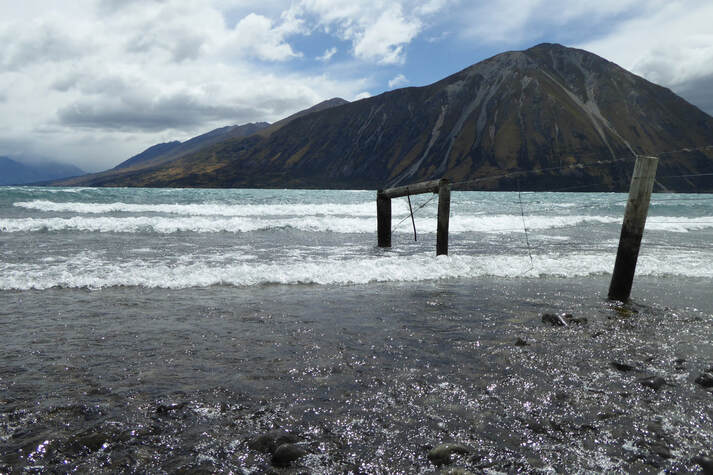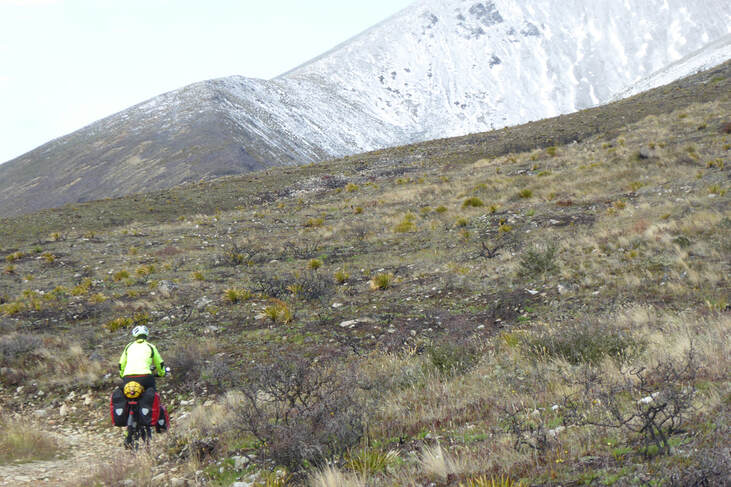Alps to Alps
2021.01.15
New Zealand - South Canterbury & North Otago
This article was written by Sharon and was first published in Daily Encourager.
Powering the Mackenzie
The hydro lakes, canals and dams of the Mackenzie Country and Waitaki Valley in the South Island provide stunning scenery for tour cycling.
We’d intended going on the Alps 2 Ocean Cycle Trail (A2O), however one-way transportation to begin in Tekapō was too expensive. So, my husband Kel devised an alternative route incorporating some of the A2O.
The two of us started and ended in the Canterbury town of Waimate, where distant relatives kindly allowed us to leave our car. We set off with our trusty tent, camp stove, food and clothes for all weathers. We were certainly to need these, this changeable January.
The first two days were glorious riding, through undulating farmland with sheep, cows, verdant green fields, and verges blooming with Scottish thistles, borage and clover.
These days dawned cloudy and were soon hot, with us recording 37 deg C on the bike. It was about 30 deg C off the bikes and we were grateful for shady trees at the former Blue Cliffs School, where we cooked lunch.
We pedalled our Hungarian road bikes with 32 mm-wide tyres and mountain bike gearing along hilly, back country gravel roads, passing farmers in utes and a shearing gang at work.
After a cold drink at the friendly Cave Arms Tavern, about 23 km north-west of Timaru, we joined a smattering of other campers at the nearby O’Neill’s Reserve, a pleasant, free, riverside camp-site.
The two of us started and ended in the Canterbury town of Waimate, where distant relatives kindly allowed us to leave our car. We set off with our trusty tent, camp stove, food and clothes for all weathers. We were certainly to need these, this changeable January.
The first two days were glorious riding, through undulating farmland with sheep, cows, verdant green fields, and verges blooming with Scottish thistles, borage and clover.
These days dawned cloudy and were soon hot, with us recording 37 deg C on the bike. It was about 30 deg C off the bikes and we were grateful for shady trees at the former Blue Cliffs School, where we cooked lunch.
We pedalled our Hungarian road bikes with 32 mm-wide tyres and mountain bike gearing along hilly, back country gravel roads, passing farmers in utes and a shearing gang at work.
After a cold drink at the friendly Cave Arms Tavern, about 23 km north-west of Timaru, we joined a smattering of other campers at the nearby O’Neill’s Reserve, a pleasant, free, riverside camp-site.
The second day, we whizzed along State Highway 8 and ascended Burkes Pass, fuelled by ice-cream, bananas and a light tail wind – always a gift for cyclists going uphill!
We felt truly in the Mackenzie Country as we rode for ages along a hot, dry valley before descending to blue Lake Tekapō. We were refreshed: visiting the picturesque stone Church of the Good Shepherd, and hot pools.
Lake Tekapō is the highest of the Mackenzie Country lakes and its maximum height is 712 m above sea level. A chain of eight hydro-electric power stations starts here, utilising water in the Mackenzie Basin and Waitaki Valley.
After our tent had survived strong winds overnight at a commercial camping ground, rain showers stopped just in time for us to pack away our waterproof helmet protectors, gloves and overtrousers.
This and the next day were warm and cloudy, as we began the A2O. We cycled beside hydro canals on excellent sealed roads and occasionally-impossible gravel ones. These canal roads were sometimes closed, other than to energy company vehicles.
We felt truly in the Mackenzie Country as we rode for ages along a hot, dry valley before descending to blue Lake Tekapō. We were refreshed: visiting the picturesque stone Church of the Good Shepherd, and hot pools.
Lake Tekapō is the highest of the Mackenzie Country lakes and its maximum height is 712 m above sea level. A chain of eight hydro-electric power stations starts here, utilising water in the Mackenzie Basin and Waitaki Valley.
After our tent had survived strong winds overnight at a commercial camping ground, rain showers stopped just in time for us to pack away our waterproof helmet protectors, gloves and overtrousers.
This and the next day were warm and cloudy, as we began the A2O. We cycled beside hydro canals on excellent sealed roads and occasionally-impossible gravel ones. These canal roads were sometimes closed, other than to energy company vehicles.
We battled high winds. One choppy canal was in a wind funnel and sideways gusts blew us off our bicycles. Thick gravel meant it was like manoeuvring through golden syrup.
We and other cyclists dismounted and pushed our bikes about a kilometre, almost getting knocked over as we struggled to hold them up against the wind.
Coming down from this windy hell was a wonderful experience, as we sped downhill and spied Lake Pūkaki, which was turquoise and an ocean blue paua colour, then morphing into opal blue.
We and other cyclists dismounted and pushed our bikes about a kilometre, almost getting knocked over as we struggled to hold them up against the wind.
Coming down from this windy hell was a wonderful experience, as we sped downhill and spied Lake Pūkaki, which was turquoise and an ocean blue paua colour, then morphing into opal blue.
Gorgeous as this, New Zealand’s most important hydro storage lake, is, we didn’t have time to stop and salivate because a storm was chasing us down the lake.
Instead we salivated upon bananas, yoghurt and tuna, and used that energy to power us into Twizel, choosing the sealed State Highway 8 over the trail.
Particularly between Twizel and Lake Ōhau, the vivid blue hydro canals were stunning and it was a privilege to ride these energy company roads.
A personal highlight of the A2O was a firmly-packed gravel track, which began at the Ōhau Weir and wound along the lake foreshore between bush both native and introduced. Birds chirped and the lake lapped.
Then the lapping became furious as coming off this sheltered path and on to the road, strong winds resumed and we were using our 1-1 gears, or, at best, 1-3. Our highest is 3-8. It was hard-going.
Because of heavy winds and rain, and plummeting temperatures, we stayed two unplanned nights at the Lake Ōhau Lodge. The upside was an open fire, showers, time to read and conversations with fellow cyclists, including North Island seniors on e-bikes.
Instead we salivated upon bananas, yoghurt and tuna, and used that energy to power us into Twizel, choosing the sealed State Highway 8 over the trail.
Particularly between Twizel and Lake Ōhau, the vivid blue hydro canals were stunning and it was a privilege to ride these energy company roads.
A personal highlight of the A2O was a firmly-packed gravel track, which began at the Ōhau Weir and wound along the lake foreshore between bush both native and introduced. Birds chirped and the lake lapped.
Then the lapping became furious as coming off this sheltered path and on to the road, strong winds resumed and we were using our 1-1 gears, or, at best, 1-3. Our highest is 3-8. It was hard-going.
Because of heavy winds and rain, and plummeting temperatures, we stayed two unplanned nights at the Lake Ōhau Lodge. The upside was an open fire, showers, time to read and conversations with fellow cyclists, including North Island seniors on e-bikes.
Once the storms cleared, snow was visible almost halfway down some mountains edging Lake Ōhau. While the views were superb, the rocky gravel track up to the Quailburn woolshed wasn’t. Recent floods had ruined sections which are being repaired.
Riding was a challenge and regularly not feasible for road bikes, each weighing between 35 and 45 kg including panniers.
However, the scenery was again spectacular and this continued for the next three days, as did improved weather.
Riding was a challenge and regularly not feasible for road bikes, each weighing between 35 and 45 kg including panniers.
However, the scenery was again spectacular and this continued for the next three days, as did improved weather.
Cycling up and across the Benmore Hydro Dam and then alongside Lake Aviemore was another highlight. The roads were sealed and quiet, and holidaying families camped by the hydro lakes.
At one stage, ahead above the lake and mountain range, dark rain clouds vied with brilliant sunlight, creating gradations of black and chocolate-coloured light. The sun won.
At Kurow, we left the A2O and continued on back roads to Waimate. We returned there seven nights after our departure, thankful for a 435 km round trip full of adventure, Kiwi conversations and the freedom bike touring offers.
If you liked this article, join up to our Daily Encourager Media Facebook page by clicking here
For further information:
The Alps 2 Ocean Cycle Trail
The Waitaki Hydro Scheme
At one stage, ahead above the lake and mountain range, dark rain clouds vied with brilliant sunlight, creating gradations of black and chocolate-coloured light. The sun won.
At Kurow, we left the A2O and continued on back roads to Waimate. We returned there seven nights after our departure, thankful for a 435 km round trip full of adventure, Kiwi conversations and the freedom bike touring offers.
If you liked this article, join up to our Daily Encourager Media Facebook page by clicking here
For further information:
The Alps 2 Ocean Cycle Trail
The Waitaki Hydro Scheme

